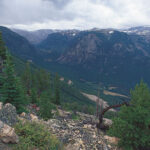The story of Sodom and Gomorrah, cities famously destroyed by divine judgment, captures the imagination of people across faiths and cultures. These cities, synonymous with sin and destruction, remain a topic of intense interest for biblical scholars, archaeologists, and anyone curious about the historical context of the Bible. Recently returning from a trip to Jordan, a region rich in biblical history, I was reminded again of the enduring questions surrounding these lost cities: Where were they located, and what happened to them?
Many people are surprised to learn that the Bible places Sodom and Gomorrah, along with the other “Cities of the Plain,” east of the Jordan River, in what is now modern-day Jordan. This area, often overlooked by typical tours to the Holy Land, is actually central to many significant Old Testament narratives. For those seeking to understand the geographical context of biblical events, exploring this region can be incredibly enlightening.
Genesis 13 provides a crucial geographical clue. After Abraham and his nephew Lot decided to part ways due to the size of their flocks and land disputes, Lot surveyed the landscape. The scripture describes how “Lot looked around and saw that the whole plain of the Jordan towards Zoar was well watered, like the garden of the Lord, like the land of Egypt, before the Lord destroyed Sodom and Gomorrah.” This passage indicates that Lot chose to settle in the fertile Jordan Valley, among the “Cities of the Plain.”
Scholarly interpretations differ on the precise location of these cities, generally falling into three geographical categories relative to the Dead Sea:
- South of the Dead Sea: This theory posits that all five Cities of the Plain were situated south of the Dead Sea’s northern tip.
- North of the Dead Sea: Conversely, some scholars suggest these cities were located north of the Dead Sea.
- Spread Across Both Regions: A third view proposes that the cities were distributed both to the north and south of the Dead Sea.
The narrative in Genesis 18 and 19 details the escalating wickedness of Sodom and Gomorrah, reaching a point where divine intervention became inevitable. Abraham intercedes, pleading for mercy, but ultimately, only Lot and his family are spared. Two angels guide Lot to safety as destruction rains down upon the cities.
 Ruins of an ancient city possibly Tel el-Hammam
Ruins of an ancient city possibly Tel el-Hammam
Intriguingly, recent archaeological research has brought a compelling location into focus: Tel el-Hammam, an archaeological site in Jordan situated north of the Dead Sea. A study published in Nature suggests that Tel el-Hammam could very well be the site of Sodom. Furthermore, researchers propose a cataclysmic event as the cause of its destruction – a mid-air meteor explosion. This cosmic event, estimated to be potentially thousands of times more powerful than the Hiroshima atomic bomb, could align with the biblical description of sudden and total devastation.
Visiting Tel el-Hammam offers a powerful experience. Standing amidst the ruins of this ancient city and rereading the biblical account of Sodom and Gomorrah brings the narrative to life. It becomes palpable that this location could indeed be where Lot fled and witnessed the destruction. Further insights into the geographical context can be found in this article from the Times of Israel, which provides a map and detailed explanation of the Tel el-Hammam theory.
While definitive proof of Sodom and Gomorrah’s exact location remains elusive, the significance of exploring potential sites cannot be overstated. The true value lies not just in pinpointing a location on a map, but in the profound understanding gained by physically connecting with these biblical lands. Walking the terrain, experiencing the geography, and visualizing the events within their historical context dramatically enriches our comprehension of the Bible.
As I often emphasize, the Bible is populated with familiar figures, yet the places where their stories unfolded often remain distant and abstract in our minds. For pastors, teachers, and Christian leaders, journeys to the Land of the Bible are invaluable. First-hand experience in these locations equips them to teach with greater confidence, clarity, and accuracy, grounding biblical narratives in tangible reality.
Cultivating a deeper appreciation for the land and people of Israel and its surrounding regions is crucial for a richer understanding of God’s Word. By engaging with the historical and geographical context of the Bible, our faith is not only informed but also profoundly strengthened.

